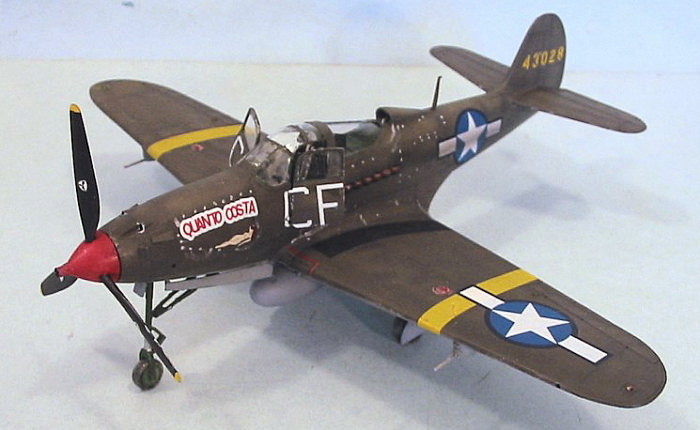
Hasegawa 1/48 P-39Q Airacobra
| KIT #: | JT 93 |
| PRICE: | 2400 yen |
| DECALS: | Three options |
| REVIEWER: | Tom Cleaver |
| NOTES: |

| HISTORY |
Often derided as the least of the fighters with which the USAAF went to war, the airplane the RAF rejected and only the Russians loved, the Bell P-39 "Airacobra" has mostly gotten a bad rap for events beyond its control, all stemming from the completely-idiotic decision by the Army Air Corps to remove the supercharger that originally equipped the prototype when it developed problems; this dropped the P-39's overall performance and crippled it at altitudes over 10,000 feet. When this was followed up by sending the airplane into combat with under-trained pilots in 1942 against the pilots of the Imperial Japanese Navy - at the time perhaps the best pilots in the world man for man - and forcing it to fight at altitudes at which it could not perform... well, no wonder it got a bad reputation.
On the other hand, the Russians - who used the airplane for combat below 10,000 feet where its performance wasn't crippled - couldn't get their hands on enough Airacobras; the airplane was flown by several of their leading aces, including second-ranked Alexsandr Pokryshkin, who scored the majority of his victories in Airacobras. In North Africa, where the airplane was used within its performance envelope, it won a respectable reputation as a low-level tactical aircraft. No less a judge of aeronautical horseflesh than Chuck Yeager called the P-39 "my favorite for all-around flying so long as you didn't take it over ten thousand feet; other than that it handled beautifully."
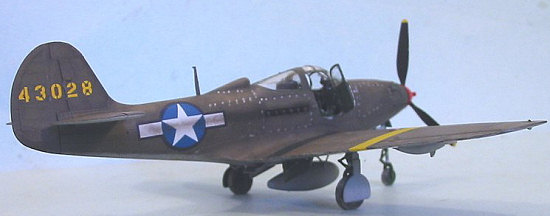 The P-39 prototype first
flew April 6, 1939. It demonstrated a climb to 20,000 feet in five minutes, and
a top speed approaching 400 m.p.h. which was admittedly achieved by an airplane
lacking armor, weapons, ammo, and other operational equipment - after Bell’s
advertising campaign about its speed, pilots were quite disappointed with the
operational airplane they flew. The heavy armament of one 37mm cannon, two .50
cal. machine guns two .30 cal. machine guns was made possible by the radical
design step of mounting the Allison engine on the aircraft's center of gravity,
behind the pilot, powering the propeller through an extension shaft. This also
allowed the airplane to become the first fighter with a tricycle landing gear,
which made it easier to handle on the ground than the conventional taildraggers.
The P-39 prototype first
flew April 6, 1939. It demonstrated a climb to 20,000 feet in five minutes, and
a top speed approaching 400 m.p.h. which was admittedly achieved by an airplane
lacking armor, weapons, ammo, and other operational equipment - after Bell’s
advertising campaign about its speed, pilots were quite disappointed with the
operational airplane they flew. The heavy armament of one 37mm cannon, two .50
cal. machine guns two .30 cal. machine guns was made possible by the radical
design step of mounting the Allison engine on the aircraft's center of gravity,
behind the pilot, powering the propeller through an extension shaft. This also
allowed the airplane to become the first fighter with a tricycle landing gear,
which made it easier to handle on the ground than the conventional taildraggers.
Unfortunately, the Army Air Corps at the time was singularly unimaginative in deciding on the use of the airplane. With an official national policy of isolationism in 1939, it was not expected that the United States would face an enemy with an effective fighter force; this meant that U.S. fighters would not need a high-altitude capability since they would be strafing invaders on the beaches. Thus, both the P-39 and P-40 were crippled at birth by the removal of the supercharging systems each prototype was originally equipped with. Only the P-38 escaped this fate since it was to be a bomber interceptor, and even the USAAC expected enemy bombers to come over at high altitude.
The British Purchasing Commission ordered the airplane as the Airacobra I, based on the P-39D configuration which was the first version produced in any numbers for the Air Force. This airplane differed from the American version by the substitution of a Hispano 20mm cannon for the Oldsmobile 37mm weapon that equipped the P-39D. By the time the Airacobras arrived in England in July 1941, air combat was regularly taking place at altitudes well over 10,000 feet; 601 Squadron found the airplane lacking in capability for ETO conditions, and the 212 Airacobras already delivered under the RAF order were sent on to the Russians, who fell in love with them for their heavy armament and good handling.
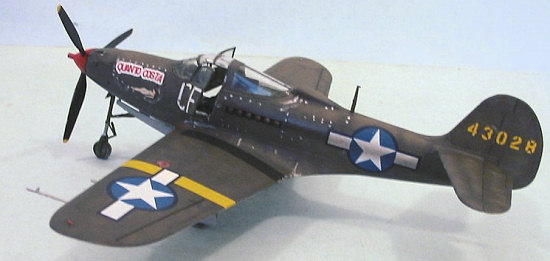 The remaining 179 aircraft
on the British order were confiscated by the USAAF after Pearl Harbor and
designated P-400 Airacobras, to distinguish them from the regular P-39s. These
airplanes were sent on to the Southwest Pacific, where they entered combat over
New Guinea with the 35th and 8th Fighter Groups in March and April 1942, and
later with the 67th Fighter Group at Guadalcanal. The P-400 was completely
outclassed by the A6M2 Model 21 Zero-sen by which it was opposed; coupling that
with the fact the IJN opponents were among the best fighter pilots in the world
made flying P-400s out of Twelve Mile 'Drome very difficult indeed. Edwards
Park - later Curator of the Smithsonian Institution - was one of those pilots;
his book "No, No, Nanette" provides an excellent account of these events.
The remaining 179 aircraft
on the British order were confiscated by the USAAF after Pearl Harbor and
designated P-400 Airacobras, to distinguish them from the regular P-39s. These
airplanes were sent on to the Southwest Pacific, where they entered combat over
New Guinea with the 35th and 8th Fighter Groups in March and April 1942, and
later with the 67th Fighter Group at Guadalcanal. The P-400 was completely
outclassed by the A6M2 Model 21 Zero-sen by which it was opposed; coupling that
with the fact the IJN opponents were among the best fighter pilots in the world
made flying P-400s out of Twelve Mile 'Drome very difficult indeed. Edwards
Park - later Curator of the Smithsonian Institution - was one of those pilots;
his book "No, No, Nanette" provides an excellent account of these events.
The P-39Q, which appeared in 1943, had an uprated Allison engine driving a paddle-bladed prop, and dispensed with the outer wing 30-caliber guns, replacing these with a singe 50-caliber heavy weapon in an underwing gondola. This greatly improved the airplane’s ground attack potential, though the Soviets generally removed these outer wing weapons when using the Airacobra in the air-superiority role.
The Tuskeegee Airmen and the P-39:
Among the units created as part of the Tuskeegee aviation program to create Air Force units manned by African-Americans was the 100th Fighter Squadron. The unit was activated on February 19, 1942 at Tuskegee Army Air Base, Alabama, but remained unmanned until it arrived at Selfridge Field, Michigan in March 1943. The squadron began operational training with the P-39 and P-40, and completed this training in December 1943. That October, the 332nd Fighter Group was commissioned under the command of LCOL Benjamin O. Davis, who had returned from command of the 99th Fighter Squadron in North Africa, the first Tuskeegee unit to go to war. The 332nd included the 100th, 301st and 302nd Fighter Squadrons.
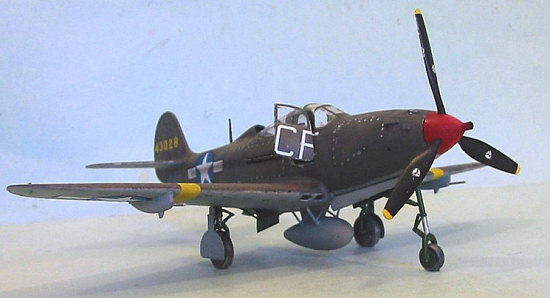 The second Tuskeegee unit
to go to the war zone, the 100th Fighter Squadron sailed in January
1944 aboard the USS “William Few”, arriving in Italy in February 1944, where
they were assigned to the Twelfth Air Force. The unit received P-39Qs that were
passed down from the 370th Fighter Squadron, which was preparing to
transition to the P-47 Thunderbolt, while the 301st and 302nd
Fighter Squadrons also received war-weary P-39s. The 100th flew its first
combat mission on its second anniversary, February 19, 1944. Because the P-39
was not considered a first-line aircraft at this time, and because the Air Force
commanders did not believe the pilots of the 332nd FG were “combat
worthy” - this despite the record compiled by the 99th Fighter
Squadron which was assigned to the 79th Fighter Group - the Group was
based at Naples and assigned to harbor protection, point-to-point patrol, convoy
escort, and armed reconnaissance missions alongside a Free French unit also
equipped with P39Qs. The squadrons also performed air rescue and a few front
line strafing missions.
The second Tuskeegee unit
to go to the war zone, the 100th Fighter Squadron sailed in January
1944 aboard the USS “William Few”, arriving in Italy in February 1944, where
they were assigned to the Twelfth Air Force. The unit received P-39Qs that were
passed down from the 370th Fighter Squadron, which was preparing to
transition to the P-47 Thunderbolt, while the 301st and 302nd
Fighter Squadrons also received war-weary P-39s. The 100th flew its first
combat mission on its second anniversary, February 19, 1944. Because the P-39
was not considered a first-line aircraft at this time, and because the Air Force
commanders did not believe the pilots of the 332nd FG were “combat
worthy” - this despite the record compiled by the 99th Fighter
Squadron which was assigned to the 79th Fighter Group - the Group was
based at Naples and assigned to harbor protection, point-to-point patrol, convoy
escort, and armed reconnaissance missions alongside a Free French unit also
equipped with P39Qs. The squadrons also performed air rescue and a few front
line strafing missions.
In April 1944, the 332nd Fighter Group was re-equipped with P-47s and assigned to the ground attack role. Group Commander Benjamin O. Davis fought this assignment, and in May 1944 the 332nd, which now included the 99th Fighter Squadron, was reassigned to the strategic Fifteenth Air Force. In early June the unit transitioned to P-51s and the legend of the “Red Tails” began to grow.
| THE KIT |
When the Hasegawa Airacobras were announced earlier this year, many questioned why the company had decided to do this airplane, since Eduard had released good kits of it already, and even the old Monogram kit originally released in 1969 was still very acceptable.
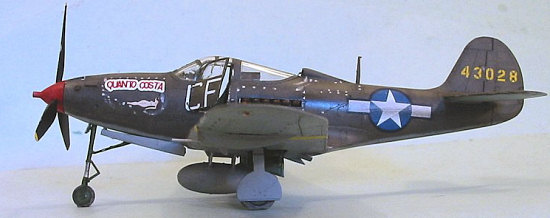 As I said when reviewing
the earlier release of the P-400, one look in the box reveals that Hasegawa has
created a kit that is superior to the existing kits. Instead of the raised
detail of the Monogram kit, it has fine recessed detail. Unlike the Eduard kit,
which has an overly-thick trailing edge on the wing, the new Hasegawa kit has
knife blade trailing edges.
As I said when reviewing
the earlier release of the P-400, one look in the box reveals that Hasegawa has
created a kit that is superior to the existing kits. Instead of the raised
detail of the Monogram kit, it has fine recessed detail. Unlike the Eduard kit,
which has an overly-thick trailing edge on the wing, the new Hasegawa kit has
knife blade trailing edges.
Both Eduard and Monogram have done nice cockpits in their kits, but in both cases resin replacements are superior. This kit from Hasegawa has a cockpit that is much better detailed than either of the others, needing only photoetched seat belts to add sufficient detail. For this project, I used the new Eduard P-39/P-400 interior detail set, which includes a superior instrument panel, seat belts, and other small details for the cockpit.
As I predicted with the earlier kit, this second release now provides all the necessary parts so that between the two releases one can do all P-39 variants other than the limited number of P-39Qs which had a 4-blade prop.
Decals are included for two P-39Qs used by the 357th Fighter Group during their training at Tonopah, Nevada, in 1943, and one P-39Q of the 347th Fighter Group at Guadalcanal in June of 1943.
| CONSTRUCTION |
The kit is extremely well-designed and really does “fall together.” After the detail parts are pre-painted, the entire assembly can be accomplished in a matter of a few hours, and no problems are presented as regards fit.
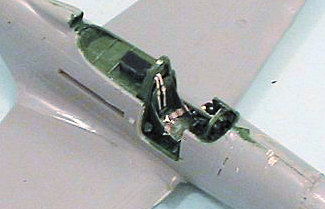 I pre-painted the detail
parts, these being the cockpit, gear wells, landing gear and gear doors, which
are all done in “Bell Green.” Having seen the P-39 restorations at Yanks Air
Museum and Fighter Rebuilders in Chino, I can assure you that this color is US
Medium Green - nothing special or out of the ordinary, other than it being a
different color from interior green which was used by most other
manufacturers. You can use any available Medium Green you want for this. In
my case, I used Xtracrylix Medium Green.
I pre-painted the detail
parts, these being the cockpit, gear wells, landing gear and gear doors, which
are all done in “Bell Green.” Having seen the P-39 restorations at Yanks Air
Museum and Fighter Rebuilders in Chino, I can assure you that this color is US
Medium Green - nothing special or out of the ordinary, other than it being a
different color from interior green which was used by most other
manufacturers. You can use any available Medium Green you want for this. In
my case, I used Xtracrylix Medium Green.
I probably doubled the amount of time spent on the cockpit of the original kit by adding on the Eduard detail parts, which really do enhance the cockpit. When all this was dry, I applied the very nice instrument panel.
I
assembled the wing with no problems, and then the fuselage. The only place I
used a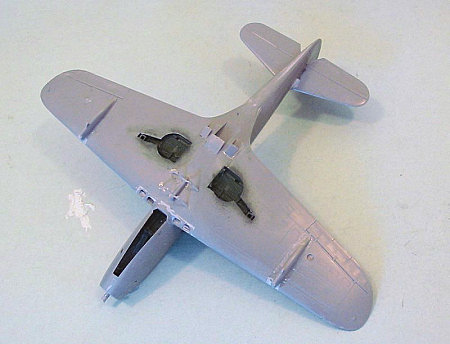 ny Mr. Surfacer was on the
fuselage to be sure I got rid of the centerline seam.
ny Mr. Surfacer was on the
fuselage to be sure I got rid of the centerline seam.
One problem with this kit is that it does not have weight provided, like the Eduard kit does. Having suffered the indignity of not providing enough weight on the earlier model and only saving it with weight in the drop tank, I put four lead fishing weights in the nose of this model and had no problem with nose-sitting. Due to the fact the gear is all the right length, model sits tail-low, so it does need more weight than you think it will.
One very nice touch is that the doors are molded in clear
plastic. All you have to do is mask both sides of the window, and then paint the doors without any problem of fitting a clear part in later. Additionally, these doors fit well enough that it is easy to assemble them closed if you want. Both the Eduard and Monogram kits are really designed for the doors to be open, and require additional fiddling to get proper fit if you want to close them. The canopy fits easily during construction.
| COLORS & MARKINGS |
Painting:
I
had decided to do “Quanto Costa” a P-39Q flown by the 100th Fighter
Squadron, which is on the Three Guys Replicas
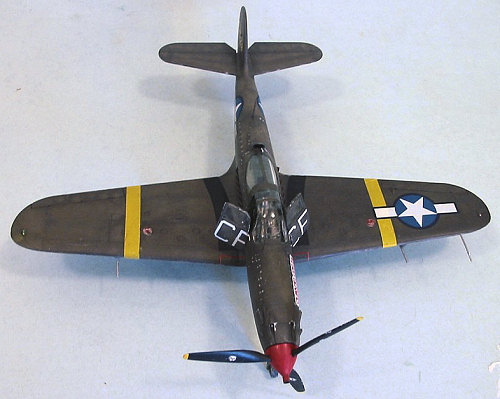 “Tuskeegee Airmen” sheet. This
sheet is no longer in production, but can be found in shops or at shows. If you
run across it I urge you to get it because all five airplanes on it are worth
doing.
“Tuskeegee Airmen” sheet. This
sheet is no longer in production, but can be found in shops or at shows. If you
run across it I urge you to get it because all five airplanes on it are worth
doing.
Since these were “war weary” P-39s that had seen previous service, I went for the “faded” look.
After preshading the model by airbrushing flat black over all the panel lines, I painted the lower surfaces with Xtracrylix “Neutral Grey” thinned 50-50 so that the black would show through and simulate grime and oil on the airframe. The upper surfaces were painted with Xtracrylix “Olive Drab”. I then mixed in some Xtracrylix “Faded Olive Drab” and went over the upper surfaces, then added in a bit of yellow and went over other areas, to get the final “sun faded” result I was going for. I then gave the model a coat of Xtracrylix Gloss Varnish.
Decals:
I used a set of “faded” national insignia from a Three Guys Replicas early Mustangs sheet, and the individual markings for “Quanto Costa” from the Tuskeegee Airmen sheet.
| FINAL CONSTRUCTION |
Once the decals were set, I “dinged” various places with Model Master Aluminum, then applied exhaust stains with Tamiya “Smoke.” I then gave the model three coats of Xtracrylix Flat Varnish.
When that was dry I unmasked the canopy and doors, glued the doors in the open position, and attached the landing gear, which I had “muddied up” with the Tamiya Weathering Set.
| CONCLUSIONS |
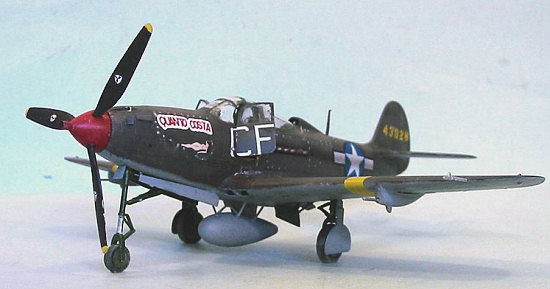 The Hasegawa Airacobra
makes into a nice model without any of the extra effort needed with either the
Monogram or Eduard kits (like sanding down the inner wing halves of the Eduard
kit to thin the wing trailing edge). The kit presents the delicateness of P-39
series very well. It is so well-designed that it is a “fall together” kit that
presents no problems during assembly, and could be a “two weekend project” for
those whose time is limited - one weekend for assembly and detail painting, one
weekend for overall painting and decals. The entire model took me about 12
hours to assemble, paint and finish. It is the kind of kit where the result
will make an average modeler look good and a good modeler look great. There are
several sheets from Cutting Edge, Eagle Strike and SuperScale for P-39Q
Airacobras, so one is certainly not limited to what is in the kit. Highly
recommended.
The Hasegawa Airacobra
makes into a nice model without any of the extra effort needed with either the
Monogram or Eduard kits (like sanding down the inner wing halves of the Eduard
kit to thin the wing trailing edge). The kit presents the delicateness of P-39
series very well. It is so well-designed that it is a “fall together” kit that
presents no problems during assembly, and could be a “two weekend project” for
those whose time is limited - one weekend for assembly and detail painting, one
weekend for overall painting and decals. The entire model took me about 12
hours to assemble, paint and finish. It is the kind of kit where the result
will make an average modeler look good and a good modeler look great. There are
several sheets from Cutting Edge, Eagle Strike and SuperScale for P-39Q
Airacobras, so one is certainly not limited to what is in the kit. Highly
recommended.
January 2007
Copyright ModelingMadness.com. All rights reserved. No reproduction in part or in whole without express permission from the editor.
If you would like your product reviewed fairly and quickly, please contact the editor or see other details in the Note to Contributors.